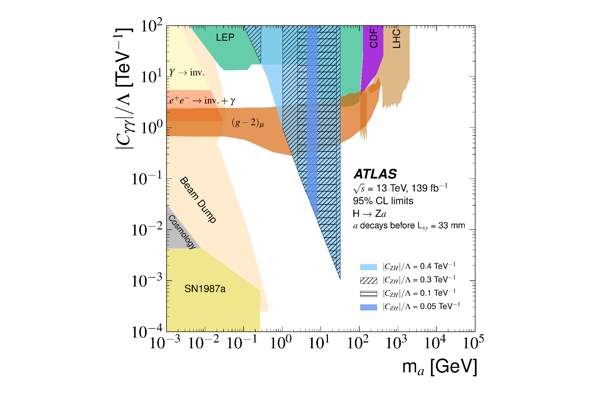Using data science to understand rare Higgs boson decays

Several LIV.DAT students have worked as part of the ATLAS collaboration while undertaking their PhDs. The ATLAS detector in the LHC at CERN collects large amounts of data and processing this data presents many data science challenges. Some of these challenges have been overcome by students working in the LIV.DAT CDT using techniques which they have learned as part of their PhD training.
LIV.DAT student Adam Ruby’s PhD presented a search for the decay of the Higgs boson into a Z boson and a light, pseudoscalar known as an axion-like particle (ALP). ALPs are particles that, if they exist, may play a role in explaining some unknown phenomena of the Standard Model, such as the strong CP-problem. ALPs are also a good dark matter candidate as they are thought to interact less frequently with matter. Work in this area has recently been published in the journal Physics Letters B as part of a paper by the ATLAS collaboration
Data recorded by the ATLAS experiment at the LHC corresponding to an integrated luminosity of 139 fb−1 from proton–proton collisions at a centre-of-mass energy of 13 TeV, was used to search for a rare decay of the Higgs boson to a 𝑍 boson and an axion particle 𝑎, with a mass between 0.1 GeV and 33 GeV. This was one of the first searches for this specific decay mode of the Higgs boson, and it probes unexplored parameter space in models with axion-like particles (ALPs) and extended scalar sectors.
The 𝑍 boson was reconstructed using an electron or muon pair, while the particle 𝑎 candidate was reconstructed from a pair of photons. The analysis accounts for the cases in which both photons are close enough to be reconstructed as a single photon in the detector, or topologies where they are reconstructed as two separate photons. No significant deviations with respect to the Standard Model predictions were observed and upper limits are set on the branching ratio of the Higgs boson decay to 𝑍𝑎 times the branching ratio 𝑎 → 𝛾𝛾, ranging from from 0.08% to 2% depending on the mass of the 𝑎 particle.
The published paper can be found here
*Image: ATLAS observed 95% CL exclusion contours limits in terms of the ALP mass and its effective coupling to photons, |Cγγ|/Λ, for different values of the Higgs coupling to Za, |CZH|/Λ. The overlaid contour limits from other direct experimental searches are shown as well. The collider bounds (LHC, LEP, CDF) are displayed at 95% CL, while the remaining bounds (SN1987a, Cosmology and Beam Dump) are presented at 90% CL. The red band shows the preferred parameter space where the (g − 2)μ anomaly can be explained at 95% CL. Image credit: the ATLAS collaboration.